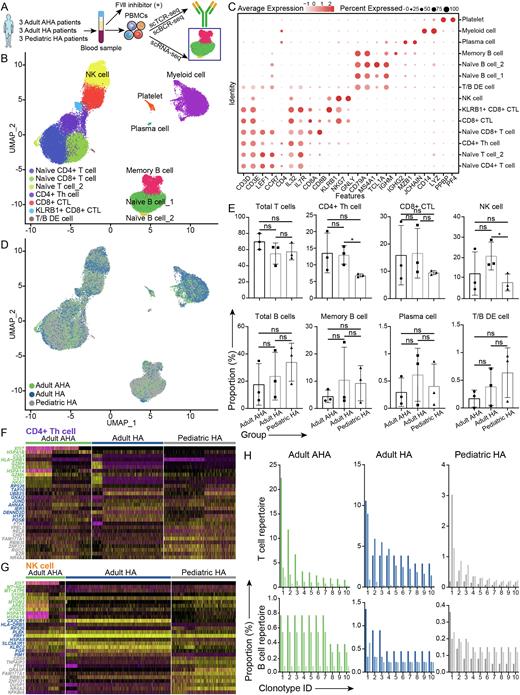Abstract
Background: FⅧ inhibitors are antibodies that neutralize the coagulation activity of FⅧ, resulting in bleeding tendency with poor prognosis, which are the products of the adaptive immune response in patients with hemophilia A (HA) after FⅧ replacement therapy or autoantibodies produced during the autoimmunity to FⅧ of patients with acquired hemophilia A (AHA). Previous studies have proposed potential mechanisms of FⅧ inhibitor production in pediatric HA patients, and the immune response to FⅧ in different types of patients remains to be studied.
Methods: PBMCs of three AHA patients, three adult patients with HA and three pediatric HA patients producing FⅧ inhibitors were isolated for single-cell (sc) RNA-seq, scBCR-seq and scTCR-seq on 10× Genomics, and Cell Ranger was used to preprocess the raw data (Fig. 1A). After the quality control of the cells, "Seurat” R package was applied to merge the data and perform transcriptome analyses including cell clustering and differential analysis.
Results and Discussion: Totally 47,458 PBMCs of the nine patients passed quality control for transcriptome analyses. PBMCs were clustered into 14 subtypes, including naïve B cell_1, naïve B cell_2, memory B cell, plasma cell, T/B dual-expressing (DE) cell, naïve CD4+ T cell, naïve CD8+ T cell, naïve T cell_2, CD4+ Th cell, CD8+ CTL, KLRB1+ CD8+ T cell, NK cell, myeloid cell and platelet (Fig. 1B), and the cell markers for annotating the clusters were shown in Fig. 1C. As depicted in Fig. 1D, PBMCs of different groups of patients have different distribution characteristics of subtypes, and some subtypes only covered several patients. For instance, naïve B cell_2 consisted of the cells from an AHA patient and an adult HA patient; naïve T cell_2 was from an AHA patient and two adult patients. Besides, T/B DE cell was mainly from pediatric HA patients, though it covered the cells from eight patients. These phenomena indicated that the immune response to FⅧ of adults might differs from that of pediatric HA patients as children's immune systems were still developing. Concerning the amounts of subtypes in different groups of patients, the proportions of CD4+ Th cells and NK cells in total lymphocytes were significantly lower in pediatric HA patients than those in adult HA patients, without any significant between pediatric HA patients and AHA patients or between adult HA patients and AHA patients. The proportions of total B cells, total T cells, CD8+ CTLs, memory B cells, plasma cells and T/B DE cells didn't show significance between any two groups of patients (Fig. 1E). Unexpectedly, Cytotoxicity-associated genes including GZMH, GZMA, GZMK and NKG7 of the CD4+ Th cells in the AHA group were upregulated compared to the other two groups, while transcription factors including JUND and FOSB in the adult HA patients were upregulated, suggesting that the CD4+ Th cells were in a relatively more obvious state of activation and proliferation (Fig. 1F). A leukocyte adhesion and migration related receptor, CX3CR1, was expressed more highly in the NK cells of the adult HA patients, and CD69, a marker of activation, was upregulated in pediatric HA patients’ NK cells (Fig. 1G). The results of the immune repertoire sequencing showed that most patients have dominant T cell clones during the immune response to FⅧ, while the B cell clone dominance was only observed in an adult HA patient. The results above suggest that the immune response to FⅧ differs among adult AHA patients, adult HA patients and pediatric HA patients, and T cells are critical in all three types of patients who produce FⅧ inhibitors.
Disclosures
No relevant conflicts of interest to declare.
Author notes
Asterisk with author names denotes non-ASH members.


This feature is available to Subscribers Only
Sign In or Create an Account Close Modal